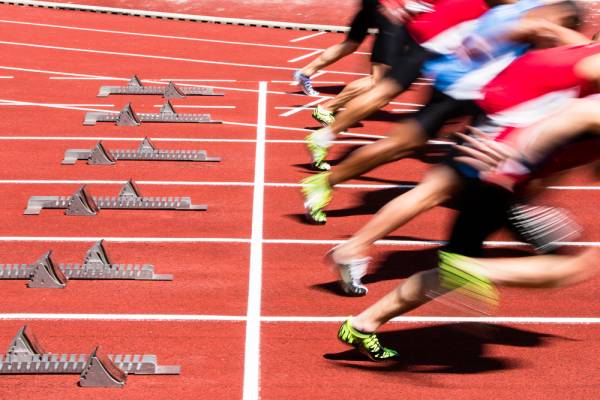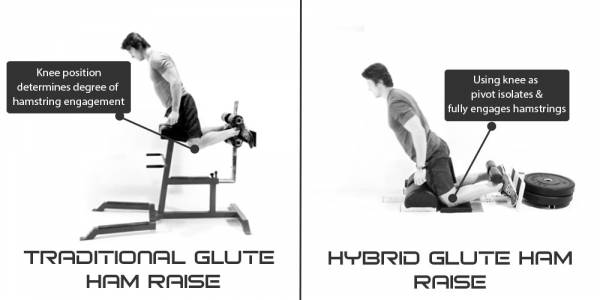Athletes with game-changing speed are like superheroes – rare, exciting, and mysterious. They might as well be wearing capes as they barrel past their opponents at what appears to be the speed of light. These athletes are capable of making unexpected and exciting plays that wow viewers and frustrate competitors. After all, impressive speed is pretty much an athletic superpower.
Of all physical abilities an athlete can posses, speed is the most valuable. Research suggests the most common characteristic among highly recruited football players is speed.1 The best players go to the best teams, and those teams win championships. So the million-dollar question becomes “How do you train to run faster?”
In order to train properly for speed development, we have to first understand the characteristics that make an athlete fast. If we understand the biomechanics of great sprinters, we can connect the dots and use research to design training programs that target and strengthen the muscles that make it possible to run faster.
What Makes an Athlete Fast?
Research shows that increasing horizontal force and power production is paramount to improving speed. Evaluation of elite 100-meter sprinter performances shows that elite sprinters produce larger horizontal ground reaction forces at higher speeds than vertical forces.2,3
“In order to train properly for speed development, we have to first understand the characteristics that make an athlete fast.”
What Makes an Athlete Really Fast?
Research shows elite sprinters also tend to have shorter ground contact times than slower sprinters.4 This suggests the ability to apply force very quickly is advantageous to better sprint times.
Training for Strength Versus Power
Strength training focuses on increasing force output by increasing the load or amount of weight an athlete uses while training. The speed of the lift isn’t necessarily important, just the amount of weight lifted. It’s obviously not easy to move quickly in a back squat loaded with 600lbs.
Power, on the other hand, is the ability to apply force quickly. Speed and force have an inverse relationship. As the speed of a movement increases, the amount of force produced decreases.
Power = (Force × Distance)/Time
In order to find the optimal load to maximize power production, an athlete should use a weight that allows for a quick movement, but also requires him or her to generate a large amount of force. Remember, elite sprinters are not only able to produce a large amount of horizontal force, but they are able to do so incredibly quickly.
The ability to generate force quickly explains why an incredibly strong football player might excel in the weight room with heavy weights but struggle in measures of power like the forty-yard dash.
Optimal Loads for Maximum Power Production
General recommendations suggest a load ranging from thirty to sixty percent of the athlete’s one-rep-max. This will provide a decent starting point for the athlete, but every athlete and exercise variation will differ when it comes to optimal loads for power production.

Breaking Down the Biomechanics of Sprinting
So we know elite sprinters are able to quickly produce massive amounts of force and primarily in a horizontal direction. Let’s break down the muscles used to generate that force and use research to help us select the best possible exercises to improve our horizontal force and power output.
Research has shown that horizontal propulsion is facilitated primarily by the hamstring muscles. Electromyography (EMG) activity shows the hamstring muscles are active longer than other hip extensor muscle.5 So, we need to focus on training our hip extensors – primarily our hamstrings – if we want to increase running speed.
All Hamstring Exercises Are Not Created Equal
A recent study in the Journal of Strength and Conditioning Research assessed the degree of muscle activation across four hamstring exercises (using EMG). The exercises were Romanian deadlifts (RDLs), glute ham raises (GHRs), good mornings, and leg curls. The exercises were tested using 85% of the participants’ one-rep-max.
“[W]e need to focus on training our hip extensors – primarily our hamstrings – if we want to increase running speed.”
The study found RDLs and GHRs produced more significant hamstring muscle activation than any other exercise.6 So, if we want to maximize hamstring strength and power gains, we need to include these two exercises in our training.
Romanian Deadlifts (RDLs)
The RDL motion is relatively straightforward, but there are subtleties to focus on to improve the effectiveness of the lift:
- Start with your feet shoulder-width apart and your toes pointing forward with a slight bend in your knees.
- As you lower the bar, stick your butt back, keeping your back flat as a board. You should feel a slight transition of your weight from the middle to the back of your foot.
- Focus on controlling the speed of the bar as you lower the weight during the eccentric (lowering) phase of the lift.
- Lower the bar as far as you can without rounding your back.
- Make the concentric (raising) phase of the lift explosive, but do not compromise form.
Glute Ham Raises (GHRs)
If you’re using a traditional glute ham machine or GHD with a semi-spherical thigh pad, placing your knees closer to the apex of the pad will engage your hamstrings more effectively than placing your knees lower on the pad. A hybrid glute ham machine is a better option for targeting and isolating the hamstrings because it uses the knee as a pivot, which increases muscle activation.

GHRs are a great exercise because there are many variations and combinations to help you mix up training and start developing explosive posterior power immediately. Choosing your GHR combos is the exciting part. With the traditional and hybrid GHDs, try the following exercise combinations. These are arranged from beginner to elite.
Standard GHR (Beginner)
To increase the difficulty of this variation, add weight to the movement. With the hybrid GHR, increasing the amount of weight by five, ten, or even fifteen pounds will be incredibly challenging. On a traditional GHR, you’ll be able to increase the amount of weight you use more aggressively.
Eccentric GHR + Reps (Intermediate)
Muscles are approximately forty percent stronger during eccentric contractions (extending out during the GHD raise, muscle lengthening) than during concentric contractions (pulling yourself up, muscle shortening). Eccentric training is a great way to quickly build strength. Eccentric GHR + Reps is probably the toughest GHR variation on the list.
- Beginner: 10 Second Eccentric/Negative Lowering + 8-10 Reps × Repeat 1
- Intermediate: 10 Second Eccentric/Negative Lowering + 8-10 Reps × Repeat 2
- Advanced: 10 Second Eccentric/Negative Lowering + 8-10 Reps × Repeat 3
- Elite: Weighted 10 Second Eccentric/Negative Lowering + 8-10 Reps × Repeat 1/2/3 (See what you can work up to!)
Altitude Drop GHR (Advanced)
Initiate this movement by relaxing your hamstrings and letting your body fall toward the ground. As your knees come within a few degrees of extension, violently contract your hamstrings to catch yourself at the bottom of the movement.
It’s important not to overextend at the bottom. Practice a few by putting your hands out in front of you to catch yourself in a push up position as you fall. Focus on contracting your hamstrings during these practice reps in order to get a sense of what the movement should feel like. You should feel a violent pull in your hamstrings at the bottom of the movement.
Rebound GHR (Elite)
Start at the top of the GHR movement. Initiate the movement by relaxing your hamstrings and letting your body fall towards the ground. As soon as your knees come within a few degrees of full extension, violently contract your hamstrings to pull yourself back to the top of the movement as quickly as possible.
Taking Advantage of the Stretch Shortening Cycle
Muscle spindles are proprioceptive organs that are sensitive to the rate and magnitude of a stretch. When a quick stretch is detected, the hamstring muscles react by producing more force than they would during the concentric or eccentric phase of the movement. If we can work to increase the amount of power that hamstrings produce, we can increase our sprinting speed.
Keep a Comprehensive Training Program
Research has shed light on the importance of horizontal force production as the most critical component to develop in order to improve speed, but that doesn’t mean we should focus solely on our hamstrings and hip extensors. Horizontal force production is also generated from forceful arm movements and powerful quadriceps. Though lifts like back squats lack specificity and have little in common with the mechanics of sprinting, studies suggest improving your one-rep-back squat max can improve sprint times.7
“If we can work to increase the amount of power that hamstrings produce, we can increase our sprinting speed.”
Conclusion
Increasing the amount of hamstring work you include in your training will significantly improve your sprint times and make you a more dynamic athlete on the field. Our focus has been on building powerful hamstrings because these are the muscles primarily responsible for propelling us down the field, track, or court but also because these muscles are under-trained and under-developed in the vast majority of athletes.
Superheroes have caves and secret lairs equipped with the latest gadgets and information to help increase their superhuman powers. Your mission, if you choose to accept it, is to incorporate more RDLs and glute ham variations into your training. While your competition is busy with the same-old training routines, you will be developing superhuman-like speed that will make your competitors fear you. Who knows, maybe someday you’ll be someone’s superhero!
Check out these related articles:
- Everything You Need to Know About Speed Training
- Speed Is Power, But It’s Not Everything
- Hamstring Mechanics During Sprinting: Insight into Injury
- What’s New on Breaking Muscle Today
References:
1. Ghigiarelli, JJ. 2009. “Combine Performance Descriptors and Predictors of Recruit Ranking for the Top High School Football Recruits from 2001 to 2009: Differences between Position Groups.” Journal of Strength and Conditioning Research 25(5):1193–203.
2. Morin, JB., et al. 2012. “Mechanical Determinants of 100-m Sprint Running Performance.” European Journal of Applied Physiology 112(11):3921–30.
3. Kugler, F., and Janshen, L., 2010. “Body Position Determines Propulsive Forces in Accelerated Running.” Journal of Biomechanics 43(2):343–8.
4. Coh, M., et al., 2001. “Morphologic and Kinematic Characteristics of Elite Sprinters.” Collegium Antropologicum 25(2):605–10.
5. Wiemann, K., and Tidow, G., 1995. “Relative Activity of Hip and Knee Extensors in Sprinting – Implications for Training.” New Studies in Athletics 1(10):29–49.
6. McAllister, MJ., et al. 2014. “Muscle Activation During Various Hamstring Exercises.” Journal of Strength and Conditioning Research 28(6):1573–80.
7. McBride, JM., 2014. “Relationship between Maximal Squat Strength and Five, Ten, and Forty Yard Sprint Times.” Journal of Strength and Conditioning Research 23(6):1633–6.
Photos courtesy of Shutterstock.






